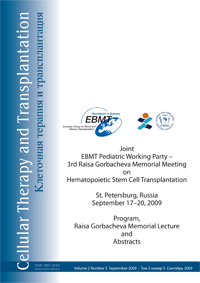Case report: combined myeloid and lymphoid lineage disorders in patient with chronic eosinophilic leukemia and T-cell lymphoma
Margarita V. Gorchakova, Ekaterina B. Rusanova, Konstantin U. Slobodnyuk, Irina J. Saburova, Elena A. Stadnik, Michail I. Zaraiski, Yekaterina E. Zueva
Department of Clinical Laboratory Diagnostics, Center for Laboratory Diagnostics, St. Petersburg Pavlov State Medical University,
St. Petersburg, Russia
Correspondence
Margarita V. Gorchakova, Department of Clinical Laboratory Diagnostics, Center for Laboratory Diagnostics, St. Petersburg Pavlov State Medical University, 6/8, Tolstoy str., St. Petersburg, 199044, Russia
E-mail: Rita.gorchakova@gmail.com
Summary
Aims
We present a rare clinical case of combined myeloid and lymphoid lineage disorders in patients with chronic eosinophilic leukemia and T-cell lymphoma.
Materials
The patient (female, 51) complained of general weakness, a permanent hyperthermia up to 38.5–39ºC, constant painful dry cough, and also she expressed redness, peeling and itchy skin on her face. An external inspection showed a significant peripheral lymphadenopathy. A clinical blood analysis revealed the following: leukocytes – 21.9 *10^9 /L, segmented neutrophils – 47%, eosinophilia – 17% (3.7 *10^9 /L), lymphocytes – 28% (6.1 *10^9 /L), monocytes – 8%, hemoglobin – 96 g /L, and ESR – 32 mm /h. Up to 44% of eosinophils were found in the myelogram.
Results
The bulk of lymphoid bone marrow cells were represented by a homogeneous population of CD2+CD3+CD4+CD5+ T-cells. A significant portion of the T-cells had an early thymic phenotype CD4+CD8+CD3+. The eosinophils phenotype was represented by markers CD13+CD15+CD33+ with a lack of CD117 and CD23. Molecular biological studies identified chimerical gene transcripts FIP1L1/PDGRFα and monoclonal T-cell receptors. The level of mRNA expression of the interleukin–5 gene was negative.
Summary
T-lymphocytes represented a clone of transformed cells confirmed by the molecular genetics data (receptor clonality) and flow cytometry (aberrant phenotype). The presence of mutations of the gene FIP1L1/PDGRFα showed the clonal nature of hypereosinophilia. A lack of increase in IL5 proved the lymphoproliferative variant of HES to be incorrect. Thus, using molecular genetics and immunological techniques we verified the presence of two diseases: chronic eosinophilic leukemia and T-cell lymphoma unspecified IVA.
Keywords
hypereosinophilic syndrome, T-cell lymphoma, case report, chronic eosinophilic leukemia


